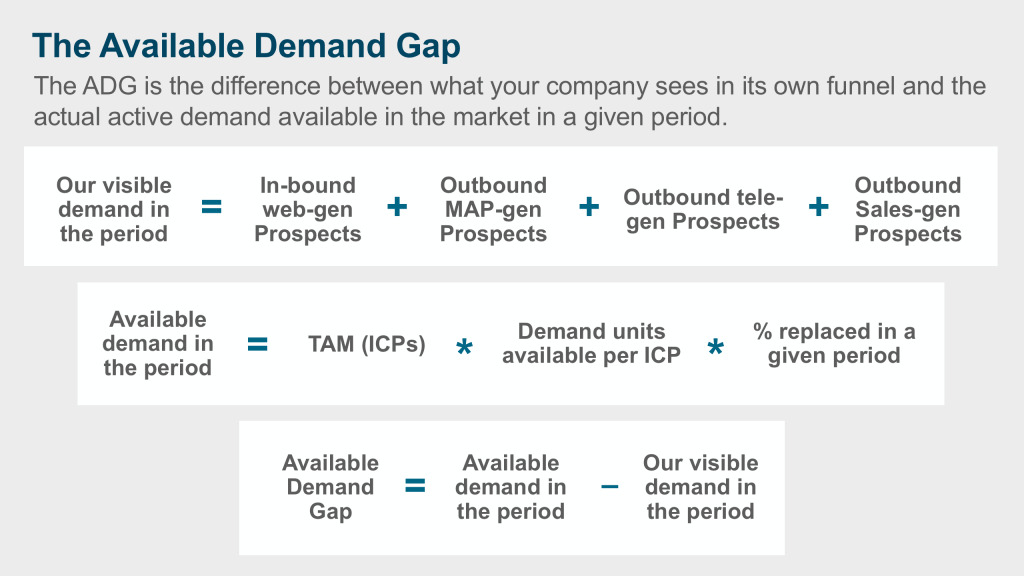- February 15, 2018
- Demand Generation, Intent Data
Closing Your Available Demand Gap
 For all of us, there exists a total addressable market (TAM) for our solutions . Meaning there is only a finite (and eminently calculable) number of companies out there who might ever buy our stuff — the sum of all companies that map to our Ideal Customer Profiles (ICPs).
For all of us, there exists a total addressable market (TAM) for our solutions . Meaning there is only a finite (and eminently calculable) number of companies out there who might ever buy our stuff — the sum of all companies that map to our Ideal Customer Profiles (ICPs).
No matter how good your business is at what it does, there’s a ceiling to how much product you can sell. It’s a fact of life for every business—at any given time, there’s a portion of your total addressable market that is actually in the market for a solution like yours. This is what is referred to as Active Demand.
There is always a gap in what demand that you actually see and what is available in the market. This is what we refer to as the Available Demand Gap (ADG). But how do you go about figuring out what your ADG is and how do you go about closing it?
What Is Your Available Demand Gap?
Simply put, your available demand gap is the difference between what you actually see in your own funnel (visible demand) and the true active demand in the market during any given time period (available demand).
Here’s how you can calculate your own ADG:
- Visible Demand: The sum of inbound web generated prospects, outbound MAP-generated prospects, outbound telemarketing-generated prospects, and outbound sales-generated prospects.
- Available Demand: The product of your ideal customer profiles (ICP), the demand units available per ICP, and the percentage replaced in a given period.
- Available Demand Gap: The difference between available demand and visible demand in the given period.

The key to adding business value and accelerating beyond your competition is to close the ADG. The only question is how.
4 Steps to Closing the Available Demand Gap
Let’s make one thing clear. You can’t close the ADG overnight.
However, the following 4 steps can set you on a path to deliver continuous strategic value by maximizing both the quality and quantity of what’s going into your marketing funnel.
1. Identifying More Available Demand
Closing the ADG requires more than a new third-party list of leads. The problem with the lists you might traditionally purchase is that they don’t identify active demand, they are just names. You only see active demand if you are able to engage with the lead. And you cannot see the active buying team (demand unit) around that lead.
You need more specific data about demand units— predictive modeling can help, but it takes time to work, and it can’t predict where demand activity is happening right now. You’ll want to identify where this activity is likely to be taking place outside of your own ecosystem – a good handle on the search terms that lead to solutions like yours is a perfect place to start.
What sites do first page Google results lead to? This will help you find the places that you need to identify, influence and engage targets through syndication, advertising or data-based offerings.
2. Taking Advantage of the Right Shortcuts
While marketing is working on filling the funnel, sales is out there prospecting on its own. In fact, at many B2B companies, 75 percent or more of all prospecting activity is executed by sales. By shifting some of your attention to supporting their account-based efforts, there’s a good chance you can help them right now.
Unlike many Top of Funnel marketing activities, closing available demand gap requires greater focus on active, late-stage demand identification. Identifying late stage demand will add significant value to sales prospecting.
But doing this alone isn’t easy, which is why we spend so much time talking about the value of reputable suppliers of intent data. Rather than starting from scratch, evaluate vendor shortcuts that can accelerate your account-based strategy more effectively.
3. Start Making an Impact on Available Demand
After you’ve identified more active demand, it’s time to influence them with your marketing messages and value propositions. It’s going to take time and money, but it can be done.
You should be able to tap your vendor for information about targeting demand units with the right types of content – many web properties make extremely rich data available to you about their audiences’ content consumption patterns.
The more you know about the audience you’re going after, the better you’ll be at increasing consideration rates before passing demand to sales.
4. Engage More of the Available Demand
The last step to closing available demand gap is to further engage the newly-identified demand units. This means targeting your audience in near-real time.
Propensity models won’t be enough. You need to know the intensity of an individual account’s demand at any given time through real, observed activity —even if they aren’t in your funnel yet.
Whether you’re doing it internally or using a third-party data offering, you need real purchase intent insights that help you focus resources properly.
When you can address all four of these steps, you’ll be positioned to close your available demand gap and deliver real value for the business. And if you want to learn more about how we can help you close your ADG faster and more effectively, contact us today.
Active Demand, B2B demand generation, demand generation, purchase intent insight



